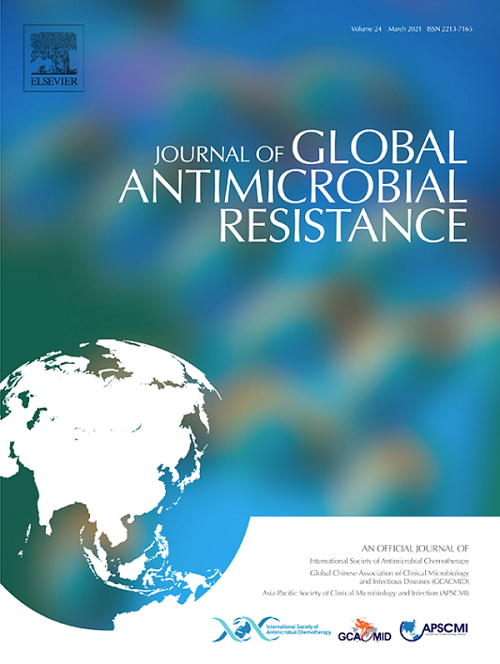艾伯塔省家禽舍生物气溶胶中非金黄色葡萄球菌物种的全基因组测序揭示了具有多种抗生素耐药基因和消毒剂耐药基因的分离株的循环
IF 3.7
3区 医学
Q2 INFECTIOUS DISEASES
引用次数: 0
摘要
目的家禽环境细菌种类繁多,以非金黄色葡萄球菌属(NASS)为主。各种NASS是鸡胃肠道和皮肤的正常居民。本研究的目的是从艾伯塔省各地蛋鸡舍的生物气溶胶中分离和鉴定NASS,从而获得分离细菌菌落的表型和基因型抗菌素耐药性(AMR)谱。方法采用XMX-CV空气微生物采样器对15个畜棚进行采样。在CMV3AGPF标准板上使用Sensititre®肉汤微量稀释法测定表型AMR谱,并进行全基因组测序(WGS)以确认物种和AMR基因。结果经WGS和比较基因组分析鉴定出7株马状葡萄球菌、5株希氏葡萄球菌、1株假木葡萄球菌、1株柯氏葡萄球菌和1株鸡状葡萄球菌。其中一株马线虫分离株在遗传上与本研究的其余分离株高度不同。表型敏感性分析显示,对林可霉素耐药的占73.3%(11/15),对四环素耐药的占66.7%(10/15),对链霉素耐药的占33.3%(5/15),对红霉素耐药的占20%(3/15),对庆大霉素耐药的占6.3%。WGS共检测到10个抗生素耐药基因和1个消毒剂耐药基因。结论含有ARGs的正常生物气溶胶菌群可能导致抗生素对家禽的治疗效果降低,这些ARGs可能是严重的公共卫生问题的来源。本文章由计算机程序翻译,如有差异,请以英文原文为准。
Whole genome sequencing of non-aureus Staphylococcus species from poultry barn bioaerosols across Alberta reveals circulation of isolates with multiple antibiotic resistant genes and disinfectant resistant genes
Objectives
Poultry environment has vast variety of bacterial species and non-aureus Staphylococcus species (NASS) are predominantly found. Various NASS are normal inhabitant of gastrointestinal tract and skin of chickens. The study objective was to isolate and identify NASS from bioaerosols of layer chicken barns across Alberta, leading to the phenotypic and genotypic antimicrobial resistance (AMR) profiling of the isolated bacterial colonies.
Methods
A total of 15 barns were sampled in this study with an XMX-CV microbial air sampler. Phenotypic AMR profiles were determined using the Sensititre® broth microdilution method on the standard CMV3AGPF plates and whole genome sequencing (WGS) was conducted to confirm the species and AMR genes.
Results
Seven Staphylococcus equorum, 5 Staphylococcus shinii, 1 Staphylococcus pseudoxylosus, 1 Staphylococcus cohnii, and 1 Staphylococcus gallinarum isolates were confirmed and identified by WGS and comparative genomic analysis. One of the S. equorum isolate was genetically highly divergent from the remaining isolates of the study. The phenotypic susceptibility profile showed 73.3% (11/15) of the isolates were resistant to lincomycin, 66.7% (10/15) were resistant to tetracycline, 33.3% (5/15) were resistant to streptomycin, 20% (3/15) were resistant to erythromycin, and 6.3% were resistant to gentamicin. A total of 10 antimicrobial resistance genes (ARGs) for antibiotics and 1 gene encoding resistance to disinfectants were detected among the study isolates by WGS.
Conclusions
Normal bioaerosol microflora having ARGs may lead to reduced therapeutic effectiveness of antibiotics in poultry and these ARGs can be a source of serious public health concern.
求助全文
通过发布文献求助,成功后即可免费获取论文全文。
去求助
来源期刊

Journal of global antimicrobial resistance
INFECTIOUS DISEASES-PHARMACOLOGY & PHARMACY
CiteScore
8.70
自引率
2.20%
发文量
285
审稿时长
34 weeks
期刊介绍:
The Journal of Global Antimicrobial Resistance (JGAR) is a quarterly online journal run by an international Editorial Board that focuses on the global spread of antibiotic-resistant microbes.
JGAR is a dedicated journal for all professionals working in research, health care, the environment and animal infection control, aiming to track the resistance threat worldwide and provides a single voice devoted to antimicrobial resistance (AMR).
Featuring peer-reviewed and up to date research articles, reviews, short notes and hot topics JGAR covers the key topics related to antibacterial, antiviral, antifungal and antiparasitic resistance.
 求助内容:
求助内容: 应助结果提醒方式:
应助结果提醒方式:


